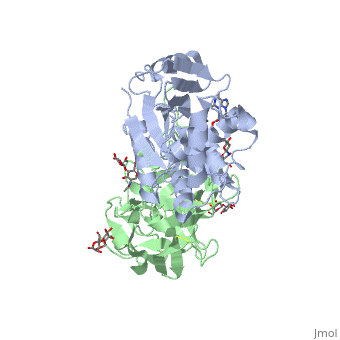Sandbox BCMB402 Ricin
From Proteopedia
Ricin is a potent cytotoxin that is synthesized in the endosperm cells of maturing seeds of the castor oil plant (Ricinus communis)[1]. Ricin belongs to a small multi-gene family[2] that is composed of eight members. Ricin is classified as a type II heterodimeric Ribosome Inactivating Protein[1] or RIPs. For toxins in Proteopedia see Toxins.
StructureRicin is a heterodimer that consists of a 32 kilodalton A chain glycoprotein (light blue) linked by a to a 32 kilodalton glycoprotein[2] (green). The is an alpha/beta protein which contains eight alpha helices (pink) and eight beta sheets (yellow). It has three domains[3]. consists of a beta sheet containing both parallel and anti-parallel strands. The makes up the core of the protein, and includes the active site. The interacts with the B chain, and contains a helix and two beta strands. The A chain contains the active site that is responsible for inactivating the Ribosome via depurination. RIPs have very diverse structures, containing only eight invariant residues[1]. These are clustered in the active site.
The B chain is a lectin[1] that to galactose-containing surface receptors. Originally it was thought that the mode of action of Ricin poisoning was due to hemagglutination due to a closely related, co-isolating lectin, RCA.
Mechanism of actionThe mechanism deployed by Ricin to gain entry to a host cell involves the poison's heterogenic properties. First, the B subunit binds to two carbohydrates on the cell surface, either glycolipids or glycoproteins, which both terminate with galactose. The interaction is facilitated by hydrogen bonds to in one domain[4] and in the other domain. Once bound, the ricin-glycoprotein complex is taken into the cells via endocytosis, and the toxin is released into the cells. This association between the A and B chain is essential for toxicity [2] without it the Ricin would not be able to gain access to the cell, rendering it useless[5].. Once the A chain gains entry into the cytosol its mechanism for attack of the ribosome is depurination of a single adenosine residue in a highly conserved portion within the large RNA of the cytoplasmic large ribosomal subunit[5] of eukaryotes; in human, the large cytoplasmic ribosomal RNA is called the 28S ribosomal RNA because of its sedimentation properties during ultracentrifugation. The nucleotide depurinated is located within a specific, conserved loop referred to as the 'sarcin-ricin loop'; the loop is critical for binding elongation factors during translation of messenger RNA to protein [6]. Depurination of the single adenosine nucleotide by the toxin results in the inhibition of protein synthesis. The proposed mechanism of depurination utilizes the in the A chain. The aromatic ring structures of the substrate adenosine stack with the aromatic side chains of , Tyr 80 and 123, above and below. Hydrogen bonds form between the conserved arginine and a backbone carbonyl. The depurination reaction is aided by the protonation of N3 by Arg 180 and by ion pairing to Glu 177. A water molecule on the opposite side of the ribose is activated by hydrogen bonding to Arg 180. The activated water attacks C1' of the ribose, releasing the adenine and depurinated RNA fragment. This interferes with elongation factor binding to the ribosome, thus inhibiting translation. | |||||||||||
Site of ricin modification of rRNA
Ricin removes an adenine from a specific portion of the 28S rRNA called the , or SRL. This leads to reduced binding of elongation factors to the ribosome and reduced synthesis of proteins. It also triggers apoptosis via activation of the JNK pathway [7].
Updated April 2013 Ricin A chain (RTA)1j1m, 1ift, 2aai, 1rtc – RTA Ricin A chain binary complexes3px8 – RTA preproricin + 7-carboxy-pterin Ricin B chain (RTB)3nbc, 3nbd – CnRTB + lactose – Clitocybe nebularis Ricin A+B chains2aai - RTA + RTB 3rtj - RTA + RTB + dinucleotide
See AlsoReferences
Contributions=The following individuals contributed to the development of this page: Douglas Read, Michal Harel, Wayne Decatur, David Canner, Alexander Berchansky, Andrea Gorrell | |||||||||||


